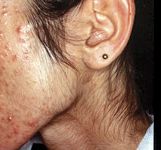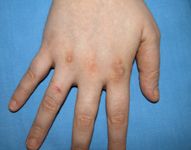- Acne
- Actinic Keratosis
- Aesthetics
- Alopecia
- Atopic Dermatitis
- Buy-and-Bill
- COVID-19
- Case-Based Roundtable
- Chronic Hand Eczema
- Chronic Spontaneous Urticaria
- Drug Watch
- Eczema
- General Dermatology
- Hidradenitis Suppurativa
- Melasma
- NP and PA
- Pediatric Dermatology
- Pigmentary Disorders
- Practice Management
- Precision Medicine and Biologics
- Prurigo Nodularis
- Psoriasis
- Psoriatic Arthritis
- Rare Disease
- Rosacea
- Skin Cancer
- Vitiligo
- Wound Care
Article
Eating disorders can be diagnosed early by recognizing skin signals
When treating patients with undiagnosed eating disorders, early recognition of dermatologic signs improves prognosis and helps dermatologists avoid æsthetic treatments intended to address such patients' unrealistic perceptions, according to an expert.

Key Points

Although experts previously believed eating disorders primarily afflicted Western cultures, recent estimates place worldwide prevalence of anorexia nervosa among young females at 0.3 percent, says Renata Strumia, M.D., a dermatologist in private practice in Ferrara and Ravenna, Italy. Additionally, prevalence rates of bulimia nervosa and binge eating are both 1 percent in this age group, she says. Dr. Strumia spoke at the 68th Annual Meeting of the American Academy of Dermatology.
One study involving a group of female ballet students found anorexia nervosa in 4.1 percent (Ringham R, Klump K, Kaye W, et al. Int J Eat Disord. 2006 Sep;39(6):503-508). "This finding supports the hypotheses that girls who must focus on achieving and maintaining a lean figure are at risk for anorexia nervosa," Dr. Strumia says.
Hirsutism also can predispose women to developing eating disorders (Morgan J, Scholtz S, Lacey H, Conway G. Int J Eat Disord. 2008 Jul;41(5):427-431). "One of the criteria for diagnosing anorexia nervosa is an altered perception of body shape," Dr. Strumia adds.

Other factors in the pathogenesis of eating disorders include genetic influences, parental concerns about weight, the psychosexual impact of puberty and the influence of peers and society, Dr. Strumia says. "The subject begins to diet. Weight loss and starvation bring mental changes, and the cycle perpetuates," she explains.
Malnutrition, excessive exercise and binging/purging behaviors lead to medical complications that can be life-threatening, Dr. Strumia says. For example, she says starvation leads to cardiac consequences such as reduced left ventricular mass. "Electrolyte imbalance is prevalent in bulimia and purging anorexia. It may lead to arrhythmias. Cardiac complications are among the most frequent causes of death in anorexia," she explains.
Skin signs

Frequent skin signs in anorexia nervosa include asteatotis, xerosis, follicular hyperkeratosis, carotenoderma, hyperpigmentation, acne, pruritus and facial dermatitis, Dr. Strumia says.
None of these common signs alone can support the suspicion of an eating disorder, "but the presence of at least four frequent signs and one guiding sign - such as lanugo-like body hair, Russell's sign or dental enamel erosion - are enough to suspect the presence of a hidden eating disorder," she says. In women, she adds, amenorrhea represents a key diagnostic feature of anorexia.
Though anorexia and bulimia are psychological disorders, "The dermatologist can suspect the presence of a hidden eating disorder when it is not yet recognized by other physicians, the patient or the patient's family."
Asteatotic skin afflicts about 70 percent of patients with anorexia nervosa. "It may occur due to a decrease in skin-surface lipids, compensatory hypothyroidism, diuretic abuse, glucose/cold intolerance, or due to compulsive washing, a sign of psychiatric comorbidity," Dr. Strumia says.

Newsletter
Like what you’re reading? Subscribe to Dermatology Times for weekly updates on therapies, innovations, and real-world practice tips.











